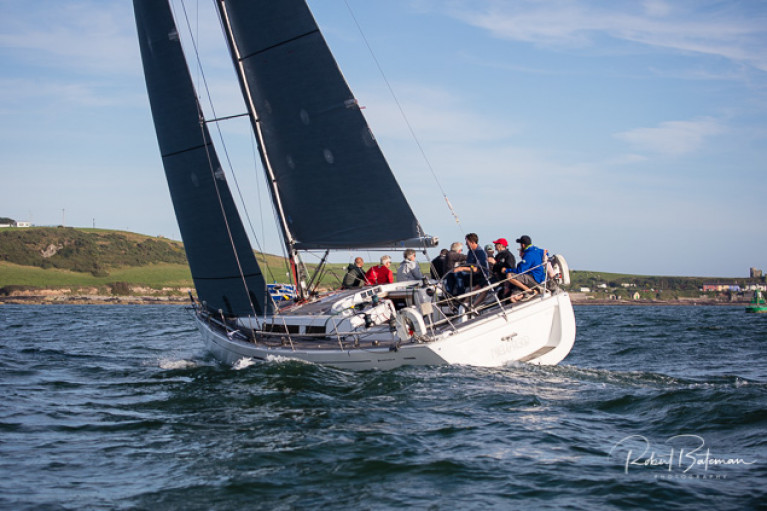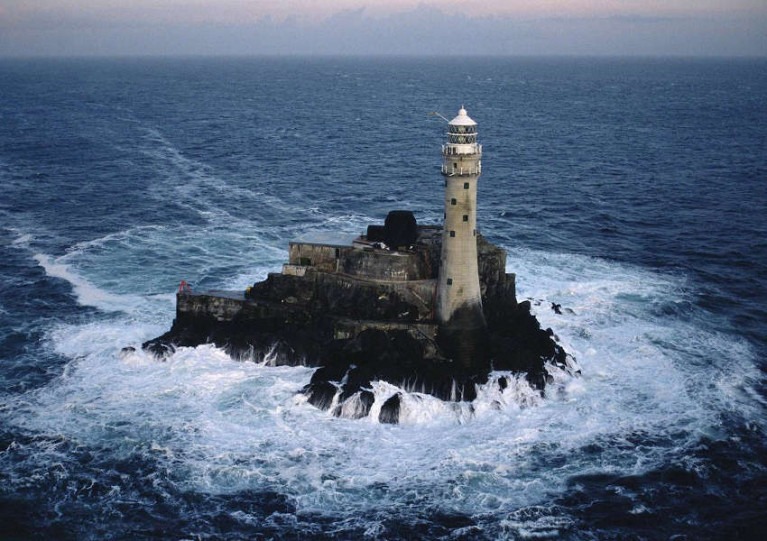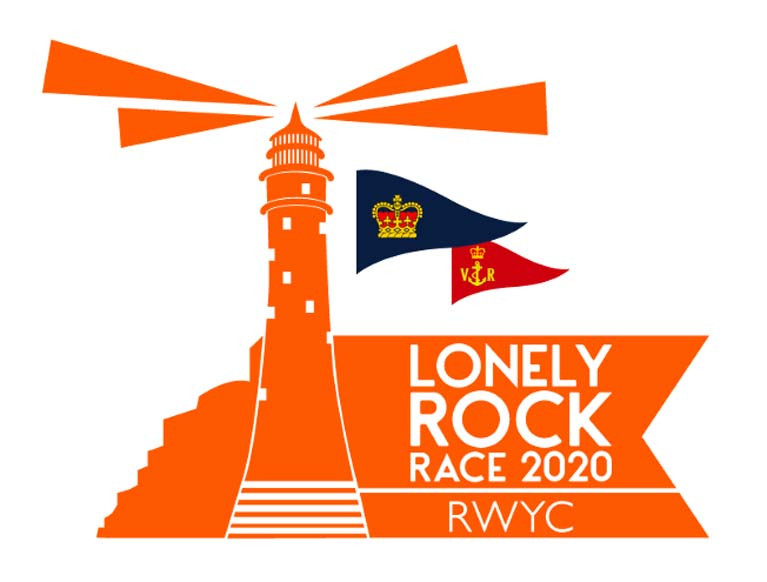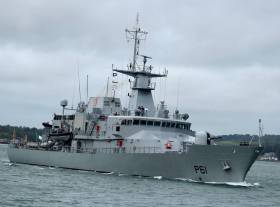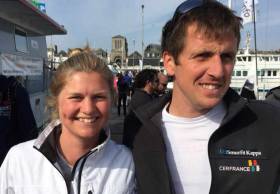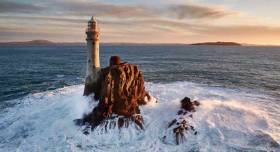Displaying items by tag: Fastnet Rock
MOD70 Trimaran PowerPlay, led by Peter Cunningham and skippered by Ned Collier Wakefield, has completed the original Fastnet Course of 595 nautical miles in a new world record of 25hrs 04mins 18secs. *Subject to ratification by the World Sailing Speed Record Council.
“It was kind of ambitious, but the conditions were right, and the team was ready to go,” commented Peter Cunningham. “The PowerPlay crew was fantastic. Miles (Seddon) did a brilliant job navigating, we had two wonderful drivers in Ned Collier Wakefield, who set up the boat and runs the programme, and the fastest sailor on Earth, Paul Larsen, who drove in some incredibly bad conditions.”
 PowerPlay rounded the famous Fastnet Lighthouse off the coast of County Cork on Monday night. The historic 595nm course starts from Cowes IOW, around Lands' End, across the Celtic Sea, around the Fastnet Lighthouse off the coast of Ireland, and finishing at the Plymouth Breakwater.
PowerPlay rounded the famous Fastnet Lighthouse off the coast of County Cork on Monday night. The historic 595nm course starts from Cowes IOW, around Lands' End, across the Celtic Sea, around the Fastnet Lighthouse off the coast of Ireland, and finishing at the Plymouth Breakwater.
Shortly after midday on Monday 05 April, in a bitterly cold strong northerly wind. PowerPlay started their Fastnet record attempt on the Squadron Line at Cowes. PowerPlay made short work of racing to Lands' End and powered across the Celtic Sea at speeds in excess of 30 knots. PowerPlay rounded the famous Fastnet Lighthouse and raced through the night. On Tuesday 06 April, at 13:42 and 19 seconds BST, PowerPlay reached the Plymouth Breakwater, where the team celebrated their amazing run of 25 hours, 4 minutes and 18 seconds.
 The PowerPlay team celebrated their amazing run of 25 hours, 4 minutes and 18 seconds Photo: Lloyd images
The PowerPlay team celebrated their amazing run of 25 hours, 4 minutes and 18 seconds Photo: Lloyd images
“We didn’t leave much out there, we were pushing really hard and everything aligned,” commented PowerPlay Skipper Ned Collier Wakefield. “I am not going to lie, it was pretty full on, especially in April with an arctic northerly with snow around. With the apparent wind we saw 50 knots over the deck, and we hit a top speed of just under 40 knots. The lads did a brilliant job, changing sails about every half an hour – It was rough, physical and very cold. As a crew we have done cumulatively over 50 Fastnet Races, we love the course and to do it faster than it has been done before is really cool.”
 PowerPlay Crew for Fastnet Course Record: Peter Cunningham, Ned Collier Wakefield, Tom Dawson, John Hamilton, Paul Larsen, Jack Trigger, Miles Seddon, Martin Watts. Photo: Lloyd images
PowerPlay Crew for Fastnet Course Record: Peter Cunningham, Ned Collier Wakefield, Tom Dawson, John Hamilton, Paul Larsen, Jack Trigger, Miles Seddon, Martin Watts. Photo: Lloyd images
The historic 595nm course starts from Cowes IOW, around Lands' End, across the Celtic Sea, around the Fastnet Lighthouse off the coast of Ireland, and finishing at the Plymouth Breakwater.
PowerPlay’s run is over two hours quicker than the record set by Phaedo3 in 2015.
The first Fastnet Race was in 1925 and won by Jolie Brise which took over six days to finish the course.
Yachts that were aiming to compete in the now-cancelled Round Ireland Race are among an expected 12-boat line-up that will contest tonight's Kinsale Yacht Club Fastnet Race sponsored by UK Sailmakers Ireland.
Among the front runners for the 100-mile race are Annamarie and Denis Murphy's Grand Soliel 40, Nieulargo that was also racing last night in Royal Cork's July league in Cork Harbour. Also starting as a contender is Cian McCarthy's new Sunfast 3300, Cinnamon Girl.
Making the trip from Dublin Bay is John Treanor's Grand Soleil 34 Justina from the National Yacht Club.
 John Treanor's Justina has made the trip from Dublin Bay for the KYC Fastnet Race Photo: Afloat
John Treanor's Justina has made the trip from Dublin Bay for the KYC Fastnet Race Photo: Afloat
Kinsale entries are expected to include Finbarr O'Regan's Artful Dodger and Tom Roche's Meridian.
The race will have an all-in start with the first gun at 6.25 pm off the Charles Fort line.
KYC will award the Fastnet Trophy to the yacht with the lowest corrected time in IRC. The Ocean Trophy shall be awarded to the yacht with the second-lowest corrected time in IRC. The Minihane Trophy shall be awarded to the yacht with the lowest corrected time in Echo. If
The forecast is for light to medium south-west winds.
West Cork Man Swims To Fastnet Rock In 40km Ocean Challenge
West Cork man Steve Redmond has become the first person to swim non-stop from Baltimore Harbour to Fastnet Rock and back, as RTÉ News reports.
The 54-year-old endurance swimmer had to content with jellyfish stings and strong currents in the cold sea water as he made the round trip to the iconic offshore island and lighthouse.
But he was also joined by some curious minke and humpback whales as he strove to complete the 40km challenge in 15 hours and 35 minutes yesterday evening, Monday 20 July.
Redmond is no strange to breaking records, however, as he was previously named World Open Water Swimming’s Man of the Year for 2012 after he completed the Oceans7 Challenge — the sea swimming equivalent of climbing the world’s seven highest peaks.
This is what exhaustion and elation look like, in a 5-second video. Steve Redmond @iswimcoldwater set out at 4.30am from #Baltimore to swim to the #Fastnet and back. 15 hours 35 minutes later he arrived back. “First time it’s been done; now I understand why,” he says... @rtenews pic.twitter.com/cMANhi4IrX
— Paschal Sheehy (@PaschalSheehy) July 20, 2020
The first Royal Western Yacht Club Lonely Rock Race will set off from the vicinity of Ryde in the Eastern Solent on 16 August 2020. The course will leave the Isles of Scilly to Port, round the Fastnet Rock to Port, pass the Isles of Scilly once again to Port and finally finish in Plymouth Sound.
Chris Arscott, RWYC Commodore, explains “It is our intention to run a Corinthian race on alternate years to the RORC Fastnet Race. We realise that there are a number of sailors and boats that may struggle to finish the RORC Fastnet Race in time for work on the following Monday due to its new length. The ‘Lonely Rock Race’ is in no way intended to replace the RORC Fastnet Race and is nothing to do with RORC in any way; indeed it is to be held in opposite years to RORC’s race and as such offers an additional opportunity to enjoy one of the most challenging Corinthian offshore race courses in the world.”
The name ‘Lonely Rock’ is a loose translation of the Gaelic name – ‘An Charraig Aonair’ for Fastnet Rock. The original course dates back to 1925 when two members of the RWYC famously made a bet on who could win a race around this notorious landmark, starting from Ryde and Finishing in the Port of Plymouth. Now, the RWYC is bringing the Corinthian spirit back to the race with an emphasis on the club sailor with a desire to take on this famous course. The entry will be open to mono and multihull yachts between 30 and 60 feet in length.
Arscott also said: “Whilst we are fully aware of the increasingly difficult and worrying times ahead with COVID-19, we feel it is important to have something to look forward to and we continue to plan for the Lonely Rock Race for now or in the future should this be necessary. We continue to monitor the situation closely.”
French Registered Fishing Boat Detained by Irish Navy off Cork Coast
A fishing vessel registered in France according to RTE News, has been detained off the Cork coast.
The Naval Service vessel LÉ Niamh detained the boat (on Wednesday) and its crew around 150 nautical miles south west of Fastnet Rock.
The detention was in connection with an alleged breach of fishing regulations.
The fishing boat is being escorted by the LÉ Niamh to Castletownbere, where it will be handed over to gardaí.
The Naval Service says this is the ninth vessel to be detained so far this year.
Fishing Vessel Detained in Irish Waters Is Portuguese
In Irish waters a Portuguese-registered fishing vessel, reports The Irish Times, was detained by the Navy Service on Thursday.
The Lé Samuel Beckett, a Naval Service patrol vessel, detained the Portuguese boat approximately 200 nautical miles south of Fastnet Rock, after an alleged breach of fishing regulations.
In a statement, the service said the Portuguese vessel was being escorted to Castletownbere, County Cork, where it will be handed over to An Garda Síochána. The detention is now a garda matter and the nature of the infringement has not been disclosed.
It is the second detainment by the service this week and the eighth of 2019. On Tuesday, Lé George Bernard Shaw detained an Irish fishing vessel off Howth.
More here on this latest detention.
Following the news that the 340 places in the biennial RORC Rolex Fastnet Race had been snapped up within minutes of entries for 2019’s race opening, Afloat understands that the Community Council on Cape Clear Island – the nearest part of Ireland to the famous rock - has been considering submissions about how best to monetise their very special rock’s unmistakable marketing appeal.
“We don’t want to appear greedy or grasping” a spokeswoman said, "but the fact is that since 1925, the international offshore racing community – a notably affluent group – have been making regular use of a very important piece of our land without paying a cent for it. It may well be that we’ve had some indirect long-term tourism benefits from the continuous appearance of the Fastnet Rock in photographs and as an international symbol of offshore racing. But we feel that it is now time for a more practical direct payment for the benefit of our isolated community”.
Cape Clear Island sources tell Afloat.ie that one way of raising income would be a “Fastnet Charge”, to be levied by the RORC as part of the entry fee, and then subsequently paid to the Community Council. The islanders are well aware of the enormous size range of boats in the Fastnet fleet, and they insist that the levy should reflect this. The suggestion is that for 2019, the fee should be €5 per metre of overall length, but the “Capers” assure us that Irish entries would be exempt, unless it became obvious that all sorts of boat-owners from all over the world were claiming to be Irish.
As negotiations are still at a preliminary and very delicate stage, Afloat.ie has been unable to get any comment on the matter from either the Royal Ocean Racing Club or sponsors Rolex. But the word in Baltimore and Schull is that the folk on the nearby mainland are with the Capers all the way, and the latest suggestion from the West Cork shore is that noted sailing celebrity and summer local Jeremy Irons of Kilcoe Castle be invited to become a Patron of the recently-formed Fellowship Administering Fastnet Fund.
Solitaire Du Figaro Returns To Ireland This Summer In 50th Gala Edition
Following last year’s performance of ‘Flying Irishman’ Tom Dolan and pioneering woman Joan Mulloy in their Solitaire du Figaro debuts, now the renowned solo offshore race is coming to Ireland.
The Solitaire URGO Le Figaro is set to return to Kinsale this summer for the first time since 2009 for its 50th gala edition, with a course that takes in a rounding of Fastnet Rock to Kinsale on the weekend of 8-9 June to end its first leg out of Nantes.
The racing fleet continues on a “marathon run” around the Irish coast through the Irish Sea, around the Isle of Man and back down the west coast of Great Britain to Roscoff in northern France.
Stage three is a loop of ‘La Manche’ back to Roscoff before the final stage, via Wolf Rock and the Isle of Wight, to Dieppe. In all the course covers 2,130 miles (not accounting for weather-related changes).
Tom Dolan has already pledged his return for his second Figaro, this time in his new Figaro 3 boat, while the presence of Joan Mulloy — Ireland’s first female entry in the race — will further buoy Irish interest in the challenge as it takes in our coast.
Dolan tells Afloat.ie that he is “itching to get going after three months of computers and meetings!”
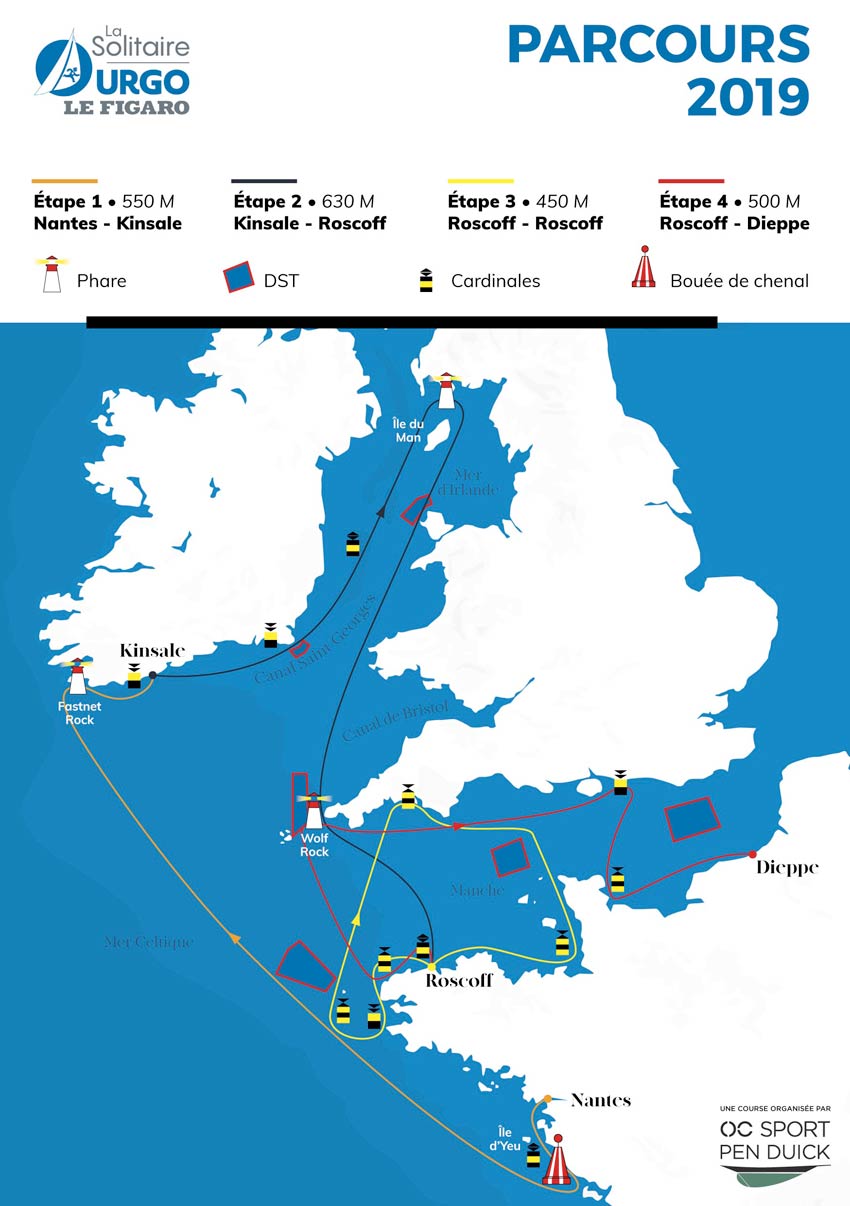
Race organisers add:
The Solitaire URGO Le Figaro is set to enter a new era this year, with the introduction of the new Figaro Bénéteau 3 for the 50th edition of the annual solo sailing race. Starting from the French city of Nantes on June 2nd, 2,130 nautical miles of challenging offshore racing around some of Europe’s roughest waters await the Figaro skippers, including a return to Ireland with a stopover in Kinsale.
Owned and organised by OC Sport’s French subsidiary OC Sport Penduick, the Solitaire URGO Le Figaro is one of the world’s toughest sailing competitions. Fiercely competitive, the race is recognised as the unofficial world championship of solo offshore racing, with the course taking just over a month to complete. Requiring a unique skill set, the Solitaire URGO Le Figaro pushes competitors to the edges of their physical and mental limits.
OC Sport Pen Duick Event Director Mathieu Sarrot commented: “This anniversary year of the Solitaire is set to be an historic edition and we are expecting a diverse fleet including previous winners and new comers to the new Figaro Bénéteau 3. This means the stakes will be high with everyone out to prove themselves in a new boat.
“On the water it will be particularly challenging,” Sarrot continued. “To be successful the competitors will need seasoned offshore experience as well as coastal knowledge. But also sheer grit and determination. With the ongoing support of our title partner URGO, it’s set to be an incredible 50th edition."
The fleet will start leg 1 under the striking bridge of Saint-Nazaire following a passage through the river Loire from the historic city of Nantes in Brittany. After rounding Île d’ Yeu, they will head across the Celtic Sea before passing the legendary Fastnet Rock and heading to the port of Kinsale, Ireland. At 500 nautical miles, the fleet will be immersed in a tough race from the off with a drag race through potentially choppy seas to keep the solo skippers on their toes before they arrive in Irish waters.
Speaking on behalf of the Kinsale Chamber of Tourism and Business, Board Member Ciaran Fitzgerald and Chairperson Guny Patel commented: “Kinsale Chamber is delighted with the announcement that the 50th Anniversary of the prestigious La Solitaire Le Figaro yacht race has been awarded to Kinsale for June 2019.
“This is an amazing event for Kinsale to host and welcome back having hosted this world famous single handed race more than any Port over the 50 years of the race. Kinsale Chamber looks forward to welcoming the sailors and visitors for what will be an incredible spectacle on sea and land over the five days of the stopover. Congratulation to Enda O'Coineen and his team for bringing this event to Ireland.”
Expected to arrive in Kinsale on Wednesday 5th June, the Solitaire URGO Le Figaro fleet will stay in Ireland until Sunday 9th June, when the skippers will set sail on the longest 630-nautical mile Leg 2 to Roscoff in northern Brittany. In a first for the Figaro fleet, this marathon stage will take the skippers along the stunning Irish coast and through the unpredictable, and at times dangerous, Irish sea before rounding the Isle of Man. A long descent along the rugged western Welsh coast, followed by a passage between Land's End and the Scilly Isles, before a crossing of the English Channel towards Roscoff will conclude what is sure to be a gruelling leg.
From Roscoff, the fleet will stay in the familiar waters of Brittany where they will tackle a 450 nautical mile coastal course that will require them to use all of their technical and tactical prowess in the strong tidal currents, before returning to Roscoff on Wednesday 19th June.
To end the 2019 Solitaire URGO Le Figaro, the increasingly exhausted fleet have a double Channel crossing to contend with. At 500 nautical miles, the final leg will see the competitors leave Roscoff on Saturday 22nd June to head across the channel towards Land’s End via a starboard rounding of the south cardinal navigation mark off Portsall. From there, they will have to negotiate the difficult conditions along the south coast of England before skirting the Isle of Wight, and crossing back into French waters through one of the world’s busiest shipping lanes. With fast depleting energy, the skippers will need to keep their wits about them as they head to a mark off Barfleur, before the final sprint into the Normandy fishing port of Dieppe.
The skippers are expected to arrive in Dieppe on Wednesday 26th June, with a non-points scoring postlogue race planned for Saturday 29th June allowing the public to see the new Figaro Bénéteau 3’s in action before the official prize giving where the winner of the 2019 Solitaire URGO Le Figaro will be crowned.
As many as 40 Figaro skippers are expected to compete in this 50th anniversary edition, including former winners alongside a plethora of young talent. At 2,130 nm, the 2019 Solitaire URGO Le Figaro course is one of the longest in race history and it will take everything in the skippers’ solo offshore arsenal to get them to the finish line.
With just over five months to go until the build-up begins in Nantes, the skippers will be using this valuable time to take delivery and train on their new Figaro Bénéteau 3’s. A full skippers line-up will be revealed in April.
La Solitaire URGO Le Figaro 2019 Schedule
May 27th: Arrival of the fleet in Nantes, France
June 2nd, Leg 1 start: Nantes, France – Kinsale, Ireland (via Fastnet Rock) – 500nm
June 9th, Leg 2 start: Kinsale, Ireland – Roscoff, France (via the Isle of Man) – 360nm
June 16th, Leg 3 start: Roscoff, France – Roscoff, France - 450nm
June 22nd, Leg 4 start: Roscoff, France – Dieppe, France – 460nm
June 26th: Anticipated arrival of first boats in Dieppe
June 29th: Postlogue and awards ceremony in Dieppe
Fastnet Rock Light Public Meeting Called
Concern has been expressed in West Cork about the effect of a proposed reduction in power in the Fastnet Rock Light after the Commissioners of Irish Lights have completed work at the famous Lighthouse during 2018 and 2019.
In a statement issued today, the Commissioners comment: “This is part of a planned programme of continuous maintenance, upkeep and modernisation of our coastal services to the mariner. The work consists of structural repairs which are necessary to ensure the metal lantern room is properly secured to the granite tower, and modernisation of the light source to an energy efficient rotating LED lantern.
When these works are completed the outward appearance of the Fastnet will be unchanged. The work will improve our environmental impact by significantly reducing the need for diesel and generators and by removing all mercury from the station. The range of the light will reduce from 27 to 18 Nautical miles.”
However, Irish Lights understands that the Fastnet is important, not only as an Aid to Navigation, but as part of the heritage of the area and as a tourism asset.
In order to provide information on the works to the West Cork community, Irish Lights are holding a Public Information Meeting at Schull Sailing Centre on Monday 5th March at 1900hrs, to which anyone with any concerns whatsoever about the future of the Fastnet Rock Lighthouse is invited.
The Fastnet Rock and its lighthouse – the most southerly part of Ireland - make up one of the best-recognised maritime structures in the world writes W M Nixon. Symbol, icon, emblem, signpost of the ocean – you name it, the Fastnet is all of these things. And the slender, beautifully-engineered lighthouse itself is central to the rock’s significance.
Since 1904 – after several previous attempts at placing a light on the rock - the glow of its beam has been moving every night along the glorious coast of West Cork. It is a familiar and much-loved part of that unique region’s heritage. It is impossible to imagine the area without it. And not surprisingly, many people want it to stay totally as it is, an unchanging constant in a changing world, a part of their lives as it was part of their parents’ and grandparents’ world before them
Yet with technology always advancing, inevitably the power source for the Fastnet Rock was becoming long out-dated, and increasingly costly to run. At the Irish Lights base in Dun Laoghaire, a new LED bulb has been developed which will provide a light in a much more economical way.
Yet if the new system is introduced, while it will still be a very powerful light, it will be one third less powerful than the present antiquated system. Naturally it is causing concern in West Cork. The Irish Times has the story here


























